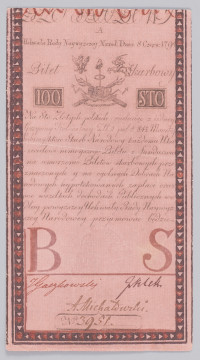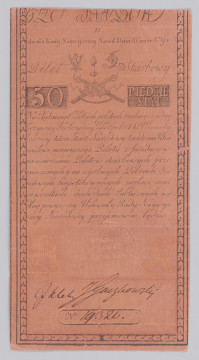
Treasury ticket - 500 Polish zlotys
1794
National Museum in Lublin
Part of the collection: Paper money of the Kościuszko Uprising and the Duchy of Warsaw
The Kościuszko Uprising is considered to have begun on 24 March 1794, when the Act of Uprising was announced. In fact, as early as 12 March, the Greater Poland National Cavalry Brigade under General Antoni Madaliński rebelled against the decisions imposed by the Russian side on the reduction of the Polish army, and started a march towards Kraków. From the outset, therefore, the uprising assumed an armed character, which entailed the need for the insurrectionary authorities to obtain the financial means necessary to wage war. This task fell to the Supreme National Council, which decided on 8 June to set up the Directorate of Treasury Bills. The task of this institution became the issuing of paper money. The lack of appropriate metal resources forced the insurrectionary authorities to use a method of increasing the circulation of money that was unknown on Polish soil. The Treasury tickets introduced into circulation were in fact not banknotes, as their issue was commissioned directly by the Treasury, not a bank. Initially, it was decided to issue tickets with the following face values: 5, 10, 25, 50, 100, 500 and 1000 zlotys. All of them were printed in the Warsaw printing house of Jan Abraham Willing on paper produced by the Dutch paper mill J Honig & Zoonen or the Flemish Pieter de (ew. di) Vries & Comp- and D & CBlau, whose names and watermarks can be found on the preserved copies. Although all denominations were put into circulation on the same day, i.e., 16 August 1794, it seems, however, that the five-pound tickets were printed first. It may be indicated by a significant number of misprints, which do not occur on tickets of higher denominations. In this respect, they are matched only by four-zloty tickets. The different denominations differed in the colour of the paper used for printing. In the case of the five-zloty tickets, it was light purple paper. There were also differences in size, which had two sources. Firstly, denominations from 5 to 50 zlotys were designed as 5 mm longer than the others. Secondly, the tickets were cut out by hand (and thus inaccurately), stapled and bound in 500 pieces, and then – also by hand – cut off when issued.
Leszek Poniewozik
Author / creator
Dimensions
cały obiekt: height: 179 mm, width: 97 mm
Object type
paper money
Technique
woodcut
Creation time / dating
Creation / finding place
Owner
The National Museum in Lublin
Identification number
Location / status

1794
National Museum in Lublin

1794
National Museum in Lublin

1794
National Museum in Lublin
DISCOVER this TOPIC
Castle Museum in Łańcut
DISCOVER this PATH
Educational path